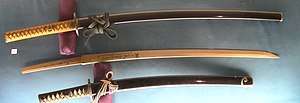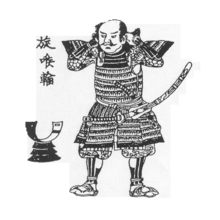Uchigatana
An uchigatana (打刀) is a type of Japanese sword worn by the samurai class of feudal Japan. The uchigatana was the descendant of the tachi.
| Uchigatana (打刀) | |
|---|---|
 Uchigatana full exterior (upper section) | |
| Type | Sword |
| Place of origin | Japan |
| Production history | |
| Produced | Muromachi period (1392–1573) |
| Specifications | |
| Blade length | 60+ cm |
History
The production of swords in Japan is divided into specific time periods:
- Jokoto (ancient swords, until around 900 CE)
- Koto (old swords from around 900–1596 CE)
- Shinto (new swords 1596–1780 CE)
- Shinshinto (new new swords 1781–1876 CE)
- Gendaito (modern swords 1876–1945 CE)[1]
- Shinsakuto (newly made swords 1953–present)[2]
From the Heian to the Muromachi Period, the primary battlefield sword was the tachi. Its long blade and sharp edge made it ideal for use on horseback. During the fifteenth century, the uchigatana came into use, and during the Muromachi Period (1336 to 1573) use of the uchigatana became widespread.[3]
The word uchigatana can be found in literary works as early as the Kamakura Period, with uchi meaning "to strike" and gatana (katana) meaning "sword", so that uchigatana means "sword to strike with".[4] The uchigatana was originally used only by individuals of low status or rank, such as the ashigaru.[5][6]
Most uchigatana made during the early Kamakura Period were not of the highest standard, and because they were considered disposable,[7] virtually no examples from these early times exist today. It was not until the Muromachi Period, when samurai began to use uchigatana to supplement the longer tachi, that uchigatana of higher quality were made. During the Momoyama period, the tachi was almost totally abandoned and the custom of wearing a pair of long and short uchigatana together (called the daishō) [8] became the dominant symbol of the samurai class.
Description

The blade length of the uchigatana during the 16th century is said to have been from 60 cm to no more than 70 cm, with a stout sugata, a steep saki-zori, and it could be used as a one handed sword due to its thin kasane (thickness) and short tang (nakago) making it relatively light.[9]
As opposed to the tachi, the uchigatana was worn edge-up in the belt,[10] this and usually being slightly smaller than the tachi was the main difference between the tachi and the uchigatana.[11] Since the uchigatana is worn differently than the tachi, the signature (mei) carved into the tang of the uchigatana is also opposite to the tachi mei, making the words still upright instead of upside down as when one wears the tachi in the manner of the uchigatana.[12]
Uchigatana became popular for several reasons, the uchigatana was more convenient to wear and did not get in the way of using a polearm as much as a tachi, also the frequency of battles fought on foot[13] and the need for speed on the battlefield, were major reasons for the uchigatana being rapidly accepted and indicated that battlefield combat had grown in intensity.[14] Since the uchigatana was shorter than the tachi, it could be used in more confined quarters, such as inside a building. Further, tactics of the period dictating unseating mounted soldiers by cutting off the mounts legs, hence mounted combat was seen as inherently disadvantageous.
Use
Unlike the tachi, with which the acts of drawing and striking with the sword were two separate actions, unsheathing the uchigatana and cutting the enemy down with it became one smooth, lightning-fast action.[15] This technique was developed in the arts of battojutsu, iaijutsu, and iaido.
The curvature of the uchigatana blade differs from the tachi in that the blade has curvature near the sword's point (sakizori), as opposed to curvature near the sword's hilt (koshizori) like the tachi. Because the sword is being drawn from below, the act of unsheathing became the act of striking. For a soldier on horseback, the sakizori curve of the uchigatana was essential in such a blade, since it allows the sword to come out of its sheath (saya) at the most convenient angle for executing an immediate cut.[16]
References
- Clive Sinclaire (1 November 2004). Samurai: The Weapons and Spirit of the Japanese Warrior. Lyons Press. pp. 40–58. ISBN 978-1-59228-720-8.
- トム岸田 (24 September 2004). 靖国刀. Kodansha International. p. 42. ISBN 978-4-7700-2754-2.
- The connoisseur's book of Japanese swords Kōkan Nagayama, Kodansha International, 1998 p.28
- Samurai: The Weapons and Spirit of the Japanese Warrior, Author Clive Sinclaire, Publisher Globe Pequot, 2004, ISBN 978-1-59228-720-8 P.81
- Samurai: The Weapons and Spirit of the Japanese Warrior, Clive Sinclaire, Globe Pequot, 2004 p.81
- Samurai, warfare and the state in early medieval Japan, Karl F. Friday, Routledge, 2004 p.79
- Lethal elegance: the art of samurai sword fittings, Joe Earle, Museum of Fine Arts, Boston, MFA Publications, 2004 p.15
- The Japanese sword, Kanzan Satō, Kodansha International, 1983 p.68
- The connoisseur's book of Japanese swords, Kōkan Nagayama, Kodansha International, 1998 P.28
- The Japanese sword, Kanzan Satō, Kodansha International, 1983 p.61
- Samurai, warfare and the state in early medieval Japan, Karl F. Friday, Routledge, 2004 p.79
- Samurai, warfare and the state in early medieval Japan, Karl F. Friday, Routledge, 2004 p.79
- Samurai: The Weapons and Spirit of the Japanese Warrior, Clive Sinclaire, Globe Pequot, 2004 p.81
- Samurai, warfare and the state in early medieval Japan, Karl F. Friday, Routledge, 2004 p.79
- Katana: The Samurai Sword: 950-1877, Stephen Turnbull, Osprey Publishing, 2010 P.22
- The Japanese sword, Kanzan Satō, Kodansha International, 1983 p.61
External links
| Wikimedia Commons has media related to Nihonto. |
